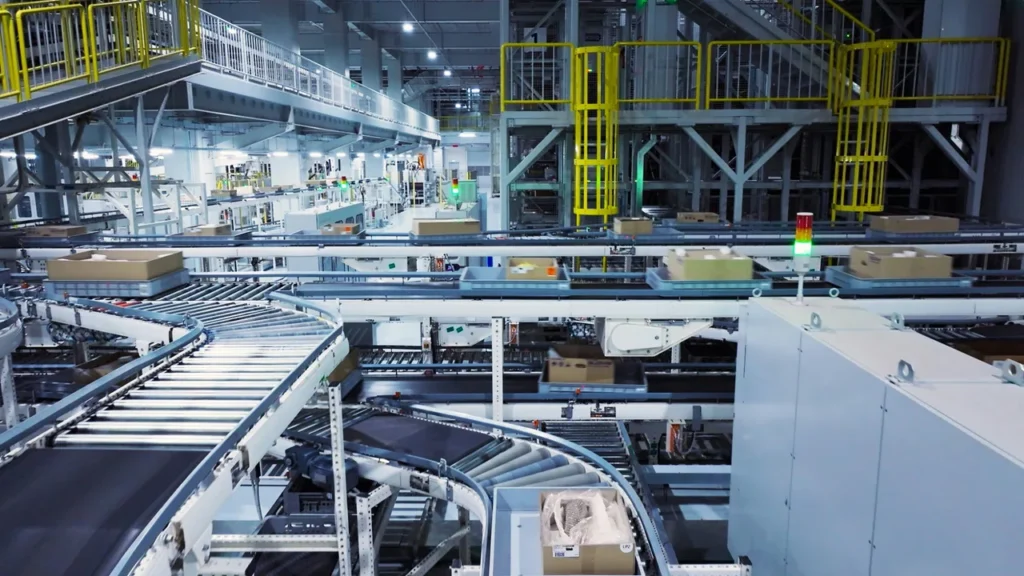In today’s rapidly evolving industrial world, the way factories manage materials has undergone a massive transformation. Material handling systems have become the backbone of modern manufacturing, ensuring that production lines run smoothly, efficiently, and safely. These systems are no longer limited to manual labor or basic mechanical equipment—they now combine automation, data intelligence, and robotics to create smarter and more sustainable production processes.
The Evolution of Modern Material Handling Systems
The manufacturing landscape has shifted from mass production to flexible, high-mix manufacturing environments. As production demands increase, companies rely heavily on material handling systems to move components, manage storage, and optimize logistics. These systems improve efficiency, reduce waste, and enhance workplace safety—all critical factors for competitiveness in the global market.
Traditionally, factories used manual carts, cranes, and forklifts for moving goods. However, as Industry 4.0 technologies emerged, automation became central to industrial logistics. Today’s systems combine intelligent conveyors, robotic arms, and AI-driven controls that allow manufacturers to monitor, analyze, and adjust operations in real time. This convergence of technology not only boosts productivity but also creates more sustainable, eco-friendly manufacturing environments.
Core Components of Material Handling Systems
Conveyors as the Backbone of Smart Factories
Conveyors have long been the workhorses of industrial material movement. In smart factories, they do much more than transport goods—they communicate data, adapt to production changes, and self-regulate speeds to avoid congestion. Whether it’s belt conveyors for lightweight products or roller conveyors for heavy-duty parts, automation and real-time monitoring make them vital for efficient flow control.
- Belt Conveyors: Ideal for consistent product movement and assembly lines.
- Roller Conveyors: Perfect for handling heavier loads with minimal energy use.
- Overhead Conveyors: Common in automotive and textile industries, saving floor space.
- Automated Guided Conveyors: Equipped with sensors and smart navigation for dynamic routing.
By integrating sensors and IoT technology, modern material handling systems track each product in motion, ensuring precision and traceability. Data collected from conveyors helps supervisors detect bottlenecks and optimize operational flow.
Automated Storage and Retrieval Systems (AS/RS)
Another cornerstone of advanced material handling systems is the Automated Storage and Retrieval System (AS/RS). These vertical, high-density storage solutions use robotic shuttles or cranes to automatically place and retrieve materials. By optimizing space and reducing human error, AS/RS significantly enhances warehouse and production line efficiency.
Modern AS/RS units connect directly with enterprise resource planning (ERP) and manufacturing execution systems (MES), allowing real-time data synchronization. This integration helps maintain inventory accuracy, improve order fulfillment speed, and reduce downtime across multiple production lines.
Robotics and Cobots in Material Handling
The rise of robotics has completely redefined manufacturing logistics. Industrial robots are now used not only for assembly but also for transporting, packaging, and palletizing materials. Collaborative robots, or cobots, work safely alongside humans, taking on repetitive and labor-intensive tasks while employees focus on higher-value activities.
For instance, cobots equipped with vision systems can detect objects, pick them up precisely, and place them in designated locations—eliminating errors and speeding up workflows. This combination of human intelligence and robotic precision has made material handling systems more adaptive and resilient to production fluctuations.
Smart Technologies Powering Logistics Automation
The Rise of IoT and AI in Manufacturing Logistics
Smart factories leverage the Internet of Things (IoT) and Artificial Intelligence (AI) to make real-time decisions in logistics operations. IoT sensors attached to conveyors and robotic equipment continuously collect data on performance, wear, and energy usage. AI algorithms then analyze this information to predict failures before they occur, reducing unplanned downtime.
Additionally, AI helps in optimizing transport routes within a factory, dynamically adjusting conveyor paths or robot navigation when congestion is detected. This level of adaptability ensures that material handling systems maintain peak efficiency at all times, even under varying production loads.
Warehouse Management Systems (WMS) and Automation Software
A crucial aspect of logistics automation lies in digital control. A modern Warehouse Management System (WMS) ensures every product, part, and pallet is tracked precisely from entry to shipment. When integrated with material handling systems, it creates a seamless flow of materials and information throughout the facility.
For example, WMS can signal an automated conveyor to reroute a package to another section if an error is detected. Through cloud-based dashboards, supervisors can monitor inventory status, order progress, and system alerts from anywhere in the world. This combination of physical automation and digital control is redefining efficiency in modern logistics.
For more insights into automation principles, you can visit Wikipedia’s guide on industrial automation.
Efficiency and Sustainability in Modern Material Handling
Energy-Saving Conveyor Drives and Smart Power Management
With global industries striving toward sustainability, material handling systems now integrate energy-efficient components. New-generation conveyor drives use variable frequency drives (VFDs) that adjust motor speeds according to load requirements. This minimizes energy waste and extends the lifespan of conveyor belts.
Smart power management systems also play a crucial role. By analyzing data from sensors and controllers, these systems automatically shut down idle conveyors, reducing electricity consumption without compromising productivity. This approach not only saves operational costs but also supports environmental initiatives in manufacturing.
Modular and Scalable System Designs
Flexibility has become one of the top priorities in manufacturing design. Modular configurations allow factories to reconfigure material handling systems based on new product lines or production targets. Instead of tearing down entire layouts, engineers can add or remove conveyor modules, lift units, or robotic arms with minimal disruption.
This modularity reduces downtime and capital expenses, while scalability enables facilities to grow at their own pace. Many logistics automation providers now design plug-and-play components that can be integrated into existing networks, helping manufacturers adapt quickly to shifting market demands or seasonal production peaks.
Sustainable Materials and Circular Economy Integration
Another innovative trend within material handling systems is the use of eco-friendly materials. Conveyor frames and support structures are increasingly made from recycled steel or aluminum alloys, while belts and rollers are designed for long service life and easy recyclability. This focus on sustainable engineering supports the circular economy concept by minimizing waste and reusing materials wherever possible.
At the same time, the growing emphasis on life-cycle management encourages manufacturers to refurbish or repurpose automation components rather than discard them. These efforts combine environmental stewardship with significant cost savings over time.
Case Studies: Real-World Applications of Material Handling Systems

Modern industries across the globe have implemented material handling systems to improve productivity, safety, and sustainability. Below are several notable examples demonstrating how automation delivers measurable results:
| Industry | Type of System | Benefit | Efficiency Gain |
|---|---|---|---|
| Automotive | Conveyor + Robotics | Faster assembly speed | +25% |
| E-commerce | AS/RS + WMS | Higher order accuracy | +40% |
| Food Processing | Hygienic Conveyors | Improved safety & hygiene | +20% |
In the automotive sector, smart conveyors and robotic arms synchronize movement along assembly lines, dramatically improving throughput while ensuring precision. Meanwhile, e-commerce fulfillment centers rely heavily on logistics automation—specifically AS/RS systems integrated with advanced WMS software—to handle thousands of orders per hour. In food processing, hygienic stainless-steel conveyors reduce contamination risk and comply with stringent health regulations.
Future Trends in Material Handling and Logistics Automation
Predictive Analytics and Machine Learning
The next frontier in material handling systems involves predictive analytics. Machine-learning algorithms evaluate operational data from sensors to forecast maintenance needs and identify potential process bottlenecks. This proactive approach reduces unexpected downtime and optimizes maintenance schedules, increasing the lifespan of critical components such as conveyors and robotic joints.
Digital Twins and Simulation Tools
Before implementing a physical system, manufacturers can now simulate an entire production line using a digital twin. This virtual model replicates the performance of real-world material handling systems, enabling engineers to test different layouts, conveyor speeds, and automation levels safely. Through simulation, companies can refine their strategies, anticipate conflicts, and validate ROI before committing to major investments.
The Role of 5G and Edge Computing
High-speed communication is essential for real-time logistics automation. With 5G connectivity and edge computing, data from thousands of sensors can be processed locally within milliseconds. This low-latency communication allows robots, conveyors, and sensors to coordinate instantaneously—preventing collisions, rerouting traffic, and maintaining precise timing on the production line.
Challenges in Implementing Smart Material Handling Systems
Despite the clear benefits, deploying material handling systems comes with several challenges:
- High Initial Investment: Advanced automation requires substantial capital for robotics, sensors, and software integration.
- System Integration: Linking new technologies with legacy machinery and IT systems can be complex and time-consuming.
- Workforce Reskilling: Employees must adapt to new digital workflows and human-machine collaboration models.
- Cybersecurity Concerns: As more equipment connects to networks, protecting sensitive production data becomes vital.
Overcoming these obstacles demands a strategic approach—starting with pilot projects, phased integration, and consistent employee training. Many manufacturers collaborate with automation specialists to ensure smooth transitions and measurable returns on investment.
Conclusion — Building the Factory of the Future
As industries embrace digital transformation, material handling systems stand at the heart of smarter, safer, and more sustainable production lines. By combining intelligent conveyors, robotics, and logistics automation software, manufacturers achieve seamless coordination between machines and people. The result is faster production, higher accuracy, and reduced environmental impact.
The innovations shaping today’s factories are laying the groundwork for tomorrow’s fully connected industrial ecosystems. From predictive maintenance to digital-twin simulations and 5G communication, every technological leap brings the vision of a fully autonomous production line closer to reality. The companies that invest in these systems today are not just upgrading equipment—they are building the factory of the future.



